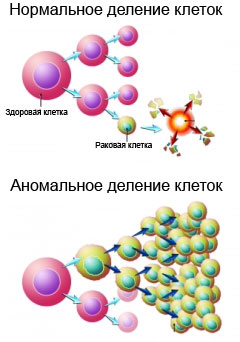Soft tissue sarcoma
Description of soft tissue sarcoma
When soft tissue sarcoma cancerous cells develop in the soft tissues of the organism. Soft tissue includes muscles, Tendon, connective tissue, fat, blood vessels, nerves, and synovial (articular) cloth.
There are many types of soft tissue sarcoma, including: the alveolar soft tissue sarcoma, angiosarkoma, desmoid sarcoma, fiʙrosarkoma, leiomyosarcoma, liposarcoma, Malignant fibrous histiocytoma, lymphoma (lymphosarcoma), Malignant tumors of peripheral nerve membranes, rhabdomyosarcoma and synovial sarcoma. Treatment is prescribed depending on the type of cancer, The location and size of the tumor.
Cancer occurs, when the cells of the organism (in this case the soft tissue cells) start uncontrollably share and form a mass of tissue, called tumor. The term cancer refers to malignant tumors, that can invade nearby tissues and spread to other parts of the body. Benign tumors do not spread to other organs.
Soft tissue sarcomas are relatively rare. Although tumors may sometimes be found in children, soft tissue sarcoma is more common in adults.

Causes of soft tissue sarcoma
Causes of soft tissue sarcoma is unknown.
Risk factors for soft tissue sarcoma
Factors, which increase the likelihood of soft tissue sarcoma:
- Exposure to certain types of chemicals:
- Chemical substances, contained in herbicides and wood preservatives;
- Polycyclic hydrocarbons;
- Dioxin;
- Exposure to radiation, including in the treatment of, diagnosis and random exposure;
- Availability of angiosarcoma of the liver in the past;
- Weak or poorly functioning immune system (including the presence of HIV infection);
- Some inherited diseases, such as:
- Li-Fraumeni syndrome;
- Nejrofiʙromatoz;
- Gardner's Syndrome;
- Retinoblastoma.
Symptoms of soft tissue sarcoma
In the early stages of a sarcoma is small and does not cause symptoms. As the tumor grows, it can put pressure on normal organs, that causes symptoms.
The most common symptom of a sarcoma is a tumor or swelling, which without being sickly. Symptoms vary depending on the body part, which is affected by the tumor. For Example, swelling in certain areas of the body can cause the following symptoms:
- Hands, legs or torso – inconvenience to the affected limb from proliferation of tumor;
- Lungs – coughing and shortness of breath;
- Intestines – abdominal pain, vomiting, constipation;
- Uterus – vaginal bleeding, and pelvic pain in the lower abdomen and.
Diagnosis of soft tissue sarcoma
The doctor will ask about your symptoms and medical history, and perform a physical examination. Your doctor may order x-rays or other tests, if you suspect the presence of a tumor. Nonetheless, the only way to confirm the diagnosis is biopsy – removal of a sample of tissue from the affected area and check it for cancer cells.
Treatment of soft tissue sarcoma
After the discovery of soft tissue sarcoma survey is conducted, allowing to determine the extent and scope of cancer. The treatment method depends on the stage and extent of disease.
Methods of treatment of soft tissue sarcoma include:
Operation with soft tissue sarcoma
The operation involves the removal of a cancerous tumor, surrounding tissue, and, perhaps, neighboring lymph nodes.
Radiation therapy for soft tissue sarcoma
Radiation therapy – Use of radiation, to kill cancer cells and shrink tumors. Therapy may be the following types:
- External radiation therapy – radiation is directed at the liver from sources outside the body;
- Internal radiation therapy – the radiation source is placed as close as possible to the cancer cells.
Chemotherapy for soft tissue sarcoma
Chemotherapy – the use of drugs to kill cancer cells. Preparations for the chemotherapy may be given in various forms: tablets, injection, the introduction of a catheter. The drugs enter the bloodstream and spread throughout the body, killing mostly cancer, and also some healthy cells. Chemotherapy, usually, It is used only for certain types of sarcomas, such as osteosarcoma (Chemotherapy is the standard treatment) or sarcoma if spread to other parts of the body (Metastasis), while medication is used to slow the rate of disease.
Prevention of soft tissue sarcoma
There are no methods for preventing soft tissue sarcoma, as the cause of its occurrence is unknown.
